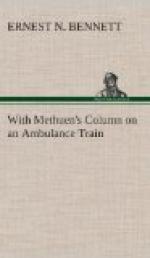There was one death at Magersfontein which seemed especially painful to ourselves. It was that of a young officer in the Argyll and Sutherland Highlanders who, after the fight on the Modder, came into our train and had a kindly word for every one of his wounded men; he walked along the wards shaking hands with them and giving them little money presents as he passed. His voice was full of sympathy, and at length he broke down utterly in his compassion for some of their terrible wounds. His tears did him credit, and we heard with genuine sorrow that he had fallen at Magersfontein. So good a man was indeed worthy of a longer life and a kindlier fate.
Almost all the wounds inflicted by the Mauser bullets seemed to be quite clean and healthy, with no signs of suppuration. It has been suggested that the satisfactory condition of such wounds is partly due to a species of cauterisation produced by the heat of the bullet. But I hardly think this can be so, for it is extremely doubtful if a bullet ever gets hot enough to cauterise flesh. I once picked up a spent Martini bullet which dropped within a yard or two of where I was standing; it was quite warm but not nearly hot enough to hurt my bare hand. A Mauser bullet fired at a fairly close range, say, 500 yards, travels at such a tremendous velocity that it generally splinters any bone it meets; on the other hand at long ranges—1,000 yards and upwards—the bullet frequently bores a clean little hole through the opposing bone and thus saves the surgeon a great deal of trouble.
The wounds from shell fire were not numerous in our wards. It seems likely that if a one-pounder shell from the Maxim-Nordenfeldt hits a man it is pretty sure to kill him. Some of the wounded men told me how terrible it was to hear the cries of a comrade ripped to pieces by this devilish missile.
The condition of the Highlanders’ legs was terrible. Many of the poor fellows lay in the open for hours—some of them from 4 A.M. to 8 P.M.—and the back of their legs was, almost without exception, covered with blisters and large burns from the scorching sun. Very many of those who had escaped bullet wounds could not, I should think, have marched ten miles to save their lives. The Highland Light Infantry wore trousers and their legs were all right. How much longer are we going to clothe our Highland regiments in kilts on active service? Every man I spoke to was dead against their use in a subtropical campaign like the present one. Besides, even as it is, our men have to put up with a compromise in the matter of kilts which makes their retention almost ridiculous, i.e., in order to screen his gay attire from the keen eyes behind the Mauser barrels every Highlander wears over the tartan a dingy apron of khaki. The war pictures we occasionally see in illustrated papers of Scotch regiments charging with flying sporrans are probably drawn in England. Even when the apron is used, the khaki jacket, the tartan kilt and the white legs offer a good mark when the wearer is lying on the ground. At Omdurman I stood with the Seaforths and Camerons in the firing line and I noticed that they appeared to lose more than any other battalion.




